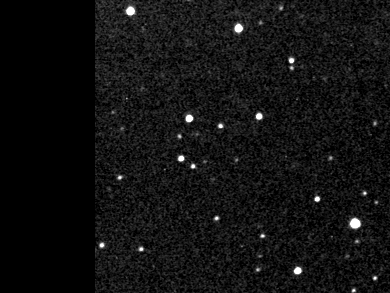
(285263) 1998 QE2 Passes 3.6 Million Miles From the Earth
May 31, 2013
 |
(285263) 1998 QE2 Passes 3.6 Million Miles From the Earth May 31, 2013 |
|
Minor Planet (285263) 1998 QE2 is an asteroid that circles the Sun every 3.77 years. Its orbit travels from the outer part of the asteroid belt (near Jupiter) all the way down to Earth's orbit. On May 31, 2013, this asteroid passed 3.6 million miles from the Earth, close by astronomical standards, but really not very close at all by human standards. There is no danger that 1998 QE2 will hit the Earth, now or in the next few hundred years. 1998 QE2 was originally discovered on August 19, 1998 by the LIncoln Near Earth Asteroid Research (LINEAR) team at White Sands Missile Range near Socorro, New Mexico. Its name comes from the year of discovery, followed by a "Q" for discovery in the last half of August and the rest is a sequential numbering. This minor planet is 1.7 miles across and recent radar imaging has shown that there is a small moonlet, about 2,000 feet across, which is orbiting it roughly every four hours. It should be noted that while radar scans of this object have been widely disseminated, these are not true images of the minor planet as we would see with our eyes. Actual pictures will have to wait until a spacecraft can visit it. The orbit of 1998 QE2 is an ellipse whose closest point to the Sun (perihelion) is still outside the Earth's orbit, but just a little. Every 3.77 years 1998 QE2 reaches this low point in its orbit on May 20, but it is still below the plane of the Earth's orbit. It finally comes through the plane of our orbit on June 1 as it starts to move farther from the Sun. But even though this happens every 3.77 years, it can only be close to the Earth if the Earth is almost in the same place in its own orbit. Most of the time, when 1998 QE2 reaches perihelion, the Earth is far away in another part of its orbit around the Sun. However, on May 31, 2013, 1998 QE2 was almost to the Earth's plane and just past perihelion as the Earth coming along in its orbit, just sunward of 1998 QE2. This put 1998 QE2 about as close as it can ever come to the Earth. It will not be this close again for at least 200 years, though there are close passes on May 16, 2119 and May 23, 2172. In both cases, 1998 QE2 will still be well below the Earth's orbital plane as the Earth passes by, so there will not be a repeat of this year's close approach. Astronomers all over the world are observing this asteroid as it makes its close pass. The radar observations have already been mentioned, but optical astronomers have also been imaging this asteroid and measuring its position to improve our knowledge of the orbit. Desert Moon Observatory has imaged this asteroid and and provided carefully measured positions to the Minor Planet Center. The images used for these measurements, each nine seconds long, were built into a short animation: 
How did 1998 QE2 get its name? As with any minor planet, as soon as a tentative orbit can be computed from the initial observations, a designation is assigned to it. In this case, 1998 comes from the year of discovery. The "Q" indicates the discovery was made in the last half of August, with the rest being a sequential assignment. After enough observations have been made, typically at least five years worth, the orbit of the minor planet is well enough known that it does not need to be observed again for a while. At this point, the Minor Planet Center assigns a sequential number to it, in this case 285263 was the next number available. The official designation is then (285263) 1998 QE2. If the discoverer should assign it a name at some time in the future, the name would replace the "1998 QE2" in the official designation. - Bert Stevens Co-director, Desert Moon Observatory, MPC #448 You can get an ephemeris (predicted positions) for this minor planet from the Minor Planet Center in Cambridge, MA. It really is a rather technical table of positions in Right Ascension (R.A.) which is like longitude in the sky and Declination (Dec.) which is like latitude. Just click the "Get Ephemerides/orbits" button below. If you want, there are more technical options below if you want to play with them.
A PDF document describing the use of the MPES (Minor Planet Ephemeris Service) is available. Information on any known problems with this service is available. Supplementary Information
This service utilizes the Minor Planet Ephemeris Service, courtesy of the IAU's Minor Planet Center. It has been made possible by Process Software Corporation, and their excellent VMS Web server, Purveyor. The calculations will be performed on the Tamkin Foundation Computing Network. Return to the Desert Moon Observatory Home Page. Last updated June 4, 2013. |